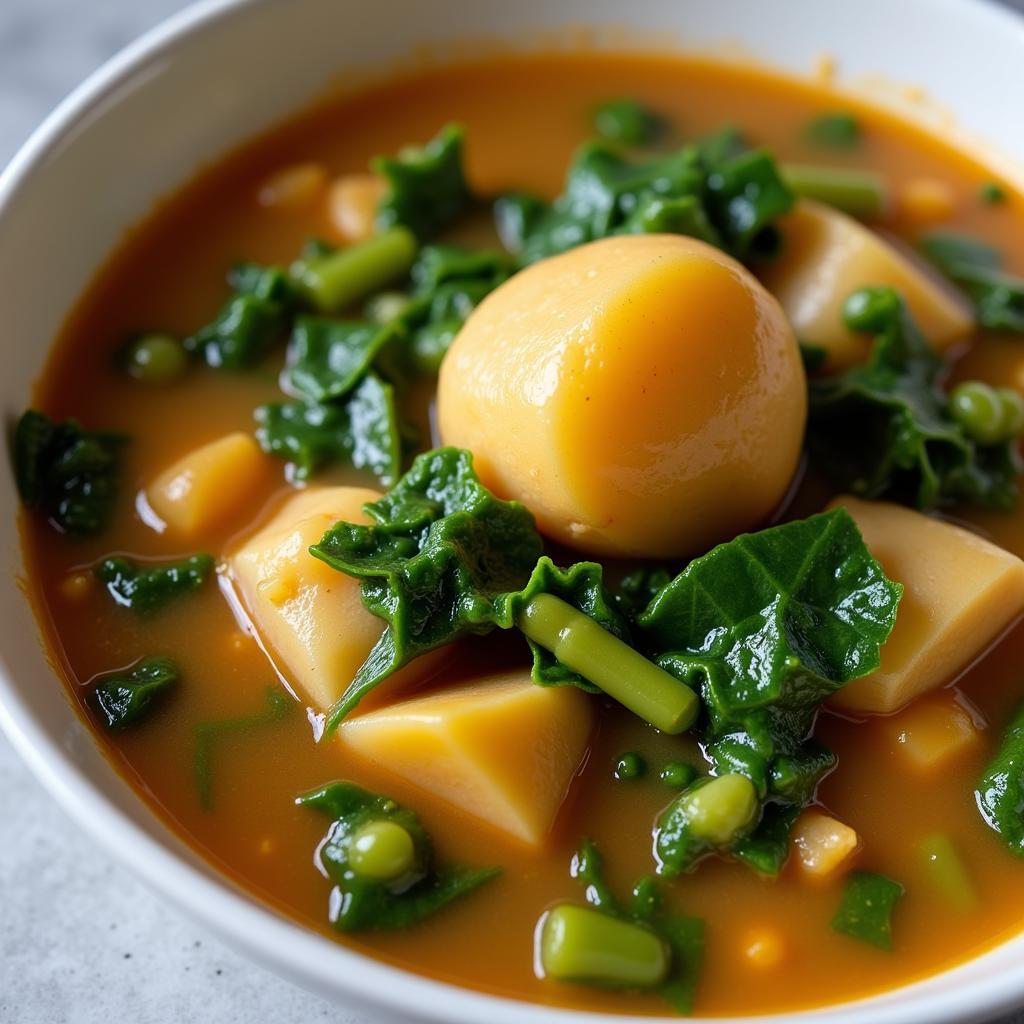Ponmo, a beloved delicacy in many West African countries, might seem unusual at first glance, but don’t let that deter you! This unique food, made from processed cow skin, holds a special place in African cuisine and offers a surprisingly delightful culinary experience.
 African market woman preparing ponmo
African market woman preparing ponmo
What Exactly is Ponmo?
Ponmo, also known as kanda, kpomo, or wele, is essentially cow skin that has undergone a thorough cleaning, scraping, and boiling process to make it edible. The result is a blank canvas for flavor, readily absorbing the spices and sauces of the dishes it’s cooked with.
Imagine a food with a texture that’s both chewy and slightly firm, similar to well-cooked calamari or even beef tendon. Now, picture that food infused with the rich, aromatic flavors of traditional African spices and stews. That’s ponmo!
A Staple in West African Cuisine
In countries like Nigeria, Ghana, and Cameroon, ponmo is more than just a dish – it’s a cultural staple. Often incorporated into soups, stews, and sauces, ponmo adds a unique textural element and readily absorbs the surrounding flavors, making each bite a burst of culinary delight.
 Plate of Nigerian Egusi Soup with Ponmo
Plate of Nigerian Egusi Soup with Ponmo
“Ponmo brings people together,” says Chef Adeola, a renowned chef specializing in Nigerian cuisine. “It’s a dish that evokes memories of family gatherings and celebrations. The unique texture and ability to soak up flavors make it a perfect addition to so many West African dishes.”
How is Ponmo Prepared?
The preparation process for ponmo plays a crucial role in its final taste and texture. It begins with meticulously cleaning the cowhide, removing any hair and impurities. Then, the skin is scraped and boiled until tender.
Once cooked, ponmo can be further seasoned and added to various dishes. It can be diced into small pieces and incorporated into soups and stews, or sliced into larger pieces and enjoyed as a standalone snack.
The Nutritional Side of Ponmo
While not as protein-packed as meat, ponmo offers some nutritional benefits. It’s a good source of collagen, a protein that plays a vital role in maintaining healthy skin, joints, and bones.
“While moderation is key, incorporating ponmo as part of a balanced diet can contribute to your collagen intake,” notes nutritionist Abena Osei. “It’s also relatively low in calories and fat, making it a healthier alternative to some other protein sources.”
 Nigerian woman enjoying a plate of ponmo stew
Nigerian woman enjoying a plate of ponmo stew
Experiencing the Delight of Ponmo
If you’re feeling adventurous and want to tantalize your taste buds with a unique culinary experience, ponmo is definitely worth a try. Its chewy texture, ability to absorb flavors, and cultural significance make it a fascinating and delicious aspect of African cuisine.
So, the next time you’re exploring West African food, be sure to venture beyond the familiar and give ponmo a chance. You might just be surprised by how much you enjoy this unusual but delightful delicacy.
FAQs about Ponmo
1. What does ponmo taste like?
Ponmo has a neutral flavor on its own, but it readily absorbs the flavors of the spices and sauces it’s cooked with. Imagine a chewy, slightly firm texture that acts like a sponge for delicious flavors.
2. Is ponmo healthy?
Ponmo is a good source of collagen, which is beneficial for skin, joint, and bone health. It’s also relatively low in calories and fat. However, like any food, moderation is key.
3. Where can I find ponmo?
You can find ponmo at African grocery stores or online retailers specializing in African food products.
4. How is ponmo cooked?
Ponmo is typically boiled until tender and then added to soups, stews, or sauces. It can also be sliced and enjoyed as a snack.
5. What are some popular ponmo dishes?
Some popular ponmo dishes include Nigerian Egusi Soup, Pepper Soup, and Efo Riro.
Need help?
For support, please contact us at Phone Number: 02437655121, Email: minacones@gmail.com Or visit us at: 3PGH+8R9, ĐT70A, Trung village, Bac Tu Liem, Hanoi, Vietnam. We have a 24/7 customer support team.